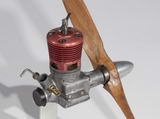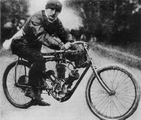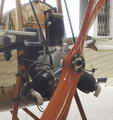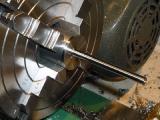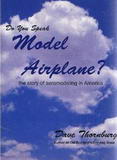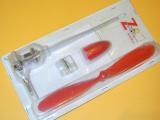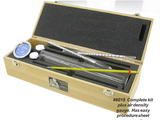Model Engine News: August 2012
Special Features:
 What Is It and Who Did It?
What Is It and Who Did It?
 Mighty Thor
Mighty Thor
 Tug's Big Tigres
Tug's Big Tigres
 Ray Arden
Ray Arden
 The Other Anzani
The Other Anzani
 BJ Cicada
BJ Cicada
 More Atom Minor
More Atom Minor
 An Altogether Irksome Task
An Altogether Irksome Task
Regular Features:
 Editorial
Editorial
 New Books and Magazines This Month
New Books and Magazines This Month
 Engine Of The Month: Enya Four-Stroke Diesels
Engine Of The Month: Enya Four-Stroke Diesels
 Tech Tip of the Month
Tech Tip of the Month
 Briefly Noted
Briefly Noted
 Standard Stuff
Standard Stuff
|
Unless otherwise expressed, all original text, drawings, and photographs created by Ronald A Chernich appearing on the Model Engine News web site are licensed under a Creative Commons Attribution-Noncommercial-Share Alike 3.0 License. |

|
Editorial
And why do we have the November 1946 cover of Model Airplane News as our lead photo? Well, one reason is that I've loved Jack Nothrop's Flying Wing ever since, as a young lad in the '50's, I first saw it in George Pal's movie version of HG Wells' War of the Worlds. Another reason is the simple purity and optimism embodied in this painting by MAN's cover artist, Jo Kotula. In Do You Speak Model Airplane, Dave Thornburg says the period between May 1927 and October 1957 was when air-mindedness was at its peak in the young of America, and other places too. To me, Kotula's covers expressed this excitement with bold background colors and great subjects. Another reason is I needed to scan an advertisement from this issue in the past month, but the best reason is the pilot of that XB-35. Kotula has him test flying the most beautiful, cutting edge hunk of technology of all time, wearing a baseball cap. I just love it!
Two of the items we have for you this month gave me an inordinate amount of trouble to write. The first looked like a simple write-up for this month's Wastzit. We thought that we'd identified it and we had, sort of. The trouble was our item was not the original and the more we dug, the more we found, and the more complicated it got. Even worse, the more I wrote about it, the more the wretched thing grew on me. Now I need another set of castings like a second hole in the head. Nevertheless, I now own a set and am contemplating the rather complicated work-holding that will be required to machine them. As you'll see, the "Answer" part of the Watzit is unusually large. So large that it almost needs it's own page. I'll think about that later.
The second trouble child was the new and long overdue Tribute to Ray Arden. I knew the basic approach I wanted to take, and sort of what I wanted to say, but the words just refused to come together. I think I've got it, finally, but can't say I'm totally sure. I hope that Adrian had an easier time with his review of Yet Another modern-day engine, This time, it's the four-stroke compression ignition version of the Enya 41 and 36C. His review *almost* made me reach for my check book.
On the home front, it's been a cold winter, so as usual, the shop has been uninhabitable. But our lemon tree is starting to sprout, so just maybe, I'll get to attack some of the several projects that have been "on ice" since May. Ruthie is off to Greece, France, Scotland, England, and Thailand this month. I'm not going as the mere thought of that amount of time cramped in an airline seat has my poor old back screaming for mercy. The work-outs at the "Y" seem to be helping though, so maybe next year. We'll see...
What Is It and Who Did It?
Sometimes, writing up a new Watzit turns into a time consuming task as what seemed simple raises niggling little doubts which require extensive sluthing. Such was the case this past month when we thought we had the identity and origin well and truly nailed for a plan and castings photo sent in by a reader. As it got written up, efforts to find out more took unexpected directions until things got turned on their little pointy head and we realized we were completely wrong in the identity, or perhaps perpetrator is a better word, for the caster of the castings in question (in our collective defense, we had managed to at least get the name of the engine shown in the plan correct). So with some pride, we now present a new Watzit with some rather curious history; click the chicken, or follow the link...
Mighty Thor
No, I absolutely refuse to take advantage of the heading and make such an obvious and over-used pun, tempting though it may be. Besides, I've already made it once before, and that should be enough. With the help of some friends who provided the excellent photos of a less than excellent engine, we've added the review of the Thor B to the list of OCR'd David Janson reviews. This, along with the GHQ (another fine piece of model aero engine history from Burnie and Arthur Winston) is actually a sought-after collectable item today. So all of you who bought one way back when, then tossed it on the trash heap in frustration and disappointment, read it and weep. And guess what? Janson could not resist making the obvious pun either...
Tug's Big Tigres
In the recent past, Ramon "Tug" Wilson (UK) has become famous for his double capacity replicas of popular 2.5cc diesels. In June 2010, we first encountered his outstanding work on the Big Racers. Readers of the Model Engineer will have followed a construction series with plans on Tug's build of the Racers. The Racer was followed a year later in July, 2011, with three Big ETAs, 5cc versions of the ETA 15 diesel which eventually and briefly took over from the Oliver Tiger as top dawg in Team Racing circles. Now, after just another year in the making, Tug has completed a pair of 5cc G32 Super Tigres. The G32, as seen here, was a 1cc diesel introduced in 1957. Follow this link to Tug's 5cc G32 in the Gallery.
Ray Arden
Google's informal motto is, "don't be evil". There are now enough instances of their broad interpretation of this ideal that the world is entitled to take it with a degree of sceptcism. Be that as it may, a lot of the work they have undertaken seems good to me. One example is their efforts to digitize old patents. Looking at our list of Pioneer Tributes, the name Ray Arden has been conspicuously absent. One reason for this has been the good coverage he has on other sites; anything I could add would be either redundant, or plagiarism, or both. But Model Engine News tries to be a bit above the rest when it comes to technological depth, so we've addressed the Arden problem by constructing a page which, with the help of Google Patents, takes us through most of his model aero engine related patents (he is supposed to have held either three of four hundred, depending on your source, so omitting a few is forgivable). Mostly he's remembered for the Glow Plug, which he did not invent, but which he did perfect. One of our Book(s) of the Month for August 2012 offers this as one of the three most important advances in post-war modeling achievements (that's WWII, the Big One). I'd have to agree.
The Other Anzani
Anzani, a French company, produced two very different three cylinder radial configuration engines. One had 120° cylinder spacing and is known as their "Y" engine to distinguish it from the other which used cylinder spacing ranging from 55° to 72°. This clustering of cylinders is known as a semi-radial, or "fan" configuration. If that sounds like a rather odd way to do business, you need to know that Alessandro Anzani, an Italian, began by building motorcycle engines and a "fan" layout was a good fit in the cycle frame! According to Wikipedia, the Anzani engine used for Louis Blériot's 1909 channel crossing monoplane was a 55° fan, while the engine installed in the Shuttleworth's Blériot monoplane is a 72° fan.
Both styles of engine have been modeled in 1/4 scale. The fan was serialized in the final three issues of SIC. Our own Les Stone built one of these. The other was designed by the late Les Chenery, using measurements taken from the Shuttleworth's Deperdussin engine. Plans and a construction series for this engine were serialized in the Model Engineer. Since Les (Stone) has built every Chenery design except this one, and since he has had the plans and castings lying around for the past 16 years, he decided it was past time to make a mate for the fan engine and complete his Chenery Collection. Visit the Les Stone Tribute Page to see external and internal pictures of Les' Anzani three cylinder "Y" radial.
BJ Cicada
Last month we hinted at a new design called the BJ Cicada, a collaboration between Chris (BollAero) Boll, and Rob (lotsathings) Jenkins. The drawings have arrived and will be given the Motor Boys Plan Set treatment over the next month or two. In the mean time, the photo shows what to expect: a simple sideport diesel with a bore of 0.437" (11.1 mm) and a stroke of 0.554" (14.07 mm), for a displacement of 0.083 cuin (1.36 cc). This is a beam mount engine and the crankcase could be hacked out of a 1.6" length of 1" square bar stock with a hacksaw and file, though milling would be a lot easier. No screwcutting is required, but some soldering is. Being a cool running diesel, you could get away with high temperature silver solder on the venturi boss to cylinder joint, but silver brazing will ensure no bits ever melt off (as sometimes happened with the old ED Penny-slot). This is the sort of engine that can be made from a reasonably stocked scrap box and even if you have to buy stock, it won't dent your bank balance. It's simple enough for beginners, with plenty of scope for experienced model engineers to indulge in some self-expression. It even has cylinder fins that Westbury would approve of!
More Atom Minor
Jan Huning's build of the Westbury Atom Minor Mk III continues this month with the Crankshaft, Contact Breaker, Rotary Disc Valve, and Propeller Hub. The photo here shows Jan turning an innocent bar of EN16M into 90% swarf and 10% crankshaft. An alternate I know at least two builders have taken is to use a piece of 1/4" diameter drill-rod (or silver steel for those in ye olde country), shrink it into a crankweb disc, and key it with a screw in the region of 6BA tapped and glued half in the disc and half in the rod. No need to harden, and I doubt any of us could harden such a length of rod without having it warp on us anyway. But Jan did it the hard way and should be congratulated for his effort.
New Books and Magazines This Month
According to some bridal site on the 'web, the saying, "Something old, something new, something borrowed, something blue...", dates back to Victorian England. What it means is complex and I suspect, of little interest to your average Model Engineer. Apparently, the saying ends with words not often repeated these days: "...and a sixpence in your shoe". Now you know, and while I don't have anything borrowed for you this month, I can dig up something old, something new, and the old thing has a blue cover, so three out of four is not bad.
First, an oldie: Do You Speak Model Airplane?, by Dave Thornburg, Pony X Press, 1992 (no ISBN). A cute title, but a bit of a mouth-full, so let's agree to call it DYSMA for short. This is one for all those who truly love model airplanes, but are too young to have enjoyed first-hand the early, pioneer days, and want to know how it all came about. True, the book is almost totally US-centric, but it is sub-titled the story of aeromodeling in America, and let's admit it, so much of our hobby has its roots in the US. All quite understandable when you consider the size of the US population, which in turn defines the size of the market, the pool of talent that fed it, and the modeling public that consumed it. In fact, DYSMA is generally the first book I turn to when researching the history of some US personality.
The book, now long out of print, spans 316 pages, divided into 12 chapters, plus a very good index—an important factor in a reference work. But this is no dry, fact-heavy text. It tells a cohesive, enjoyable story of how it started, evolved, and sadly but understandably, declined. Each chapter describes some aspect of the hobby, while somehow managing to keep the general flow in chronological order. Thornburg describes the progression from hardwood twin-pushers to "modern" R/C (if we can call late '80's R/C modern), with all the other stuff encountered along the way. He explains things even today's old-timers probably never directly experienced, such as the Jimmy Allen Air Races, or how the AMA evolved from the AMLA and NAA, and how the US NATS got started. How down-thrust and right-thrust were "invented", what Charles Grant and the "center of lateral area" debate was all about, and why the "juniors problem" has always existed, and probably always will.
The writing style is "folksy", loaded with adjectives and asides—if you'll excuse the pot calling the kettle black. Even better, Thornburg does not hesitate to call a spade a shovel when he has an opinion, or three. For example (p70):
Over a hundred thousand GHQs were sold, and almost every engine collector today [1992] who really wants one can find one—often in mint condition. Few GHQs ever wore out because so few were ever successfully started. Some said the engine was ported to run clockwise. Others claimed it had no porting at all—a fuel-saving measure that was years ahead of its time. Bernie Winston was naturally touchy on the subject of the GHQ. During the thirties he ran Saturday workshops for frustrated owners, and claimed, sometimes a bit shrilly, that he never failed to start an engine that was brought to him.
I can't really do justice to this book in any conventional kind of review. You simply have to experience Dave Thornburg's ramble through the evolution of model types, theories, the movers, the shakers, the "personalities", the inevitable charlatans, crooks, and everything else to really appreciate it. I especially like how his narrative manages to join the dots, explaining how one thing led to another and how all those names of people, companies, and products that you see in old magazines, even the names given to models, they all interconnect. It's just magic. Copies can still be found here, on Amazon, though prices are getting so alarmingly high that Ruthie has put our copy in the safe. But if you spot a copy and love model airplanes—if you are what Thornburn terms "a lifer"—grab it with both hands! Five Stars, and a well-earned Koala stamp  .
.
-oOo-
Our second offering, hot off the presses, is the Free Flight Quarterly Compressed Air Engine Book. FFQ is an Australian digest, published quarterly (duh), for Free Flight modelers (double duh). In addition to their Journal, over the years they have published a number of "books" targeted at specific area of free flight modeling, such as P30, Coup d'Hiver, etc. This is their latest offering: 84 pages in A4 size dedicated to compressed air engines, their history, construction, care and feeding thereof, and models to put them in.
The book is divided into two roughly equal parts, each of eight chapters. The first covers the early years, presenting a good historical summary, plus six different designs including one from Jems Suzor's book, Petits Moteurs pour Modèles Réduits d'Avion, MEN's Pachasa, the OTT from Bert Pond's book, two by Roy Clough Jr, the Kerzel tube engine, and a 1941 patent for a "Miniature Radial Motor" which is actually a four cylinder rotary.
Part 2 moves on to modern times, beginning with air engines made from plastics. Chris Stoddart explores the patents and "toy" engines from the 80's that can be adapted to more aerodynamic airframes. Articles reprinted from Aeromodeller by the late Doug McHard show what amazing things can be accomplished with the Italian Z model engine, including how to make a twin cylinder engine which, using a 2 litre drink bottle, wrapped with glass fibre packing tape, was pumped up to 9 bar pressure (132 psi) to give a 1:30 min engine run.
 The last chapter includes complete CAD plans and machining instructions for a very nice little CA engine designed by John Morrill. John's engine makes cunning use of two aluminum drink cans, epoxied back to back for the air tank. This engine, mounted in a scale DeHavilland Beaver with a 30" wing span managed to win both mass launch contests, plus three ROG flight duration events for compressed air engines at the 2009 SAM Champs. The book does not include plans for the Beaver, but you do get plans for Jim Sprenger's Scirocco, specially designed for the Morrill engine.
The last chapter includes complete CAD plans and machining instructions for a very nice little CA engine designed by John Morrill. John's engine makes cunning use of two aluminum drink cans, epoxied back to back for the air tank. This engine, mounted in a scale DeHavilland Beaver with a 30" wing span managed to win both mass launch contests, plus three ROG flight duration events for compressed air engines at the 2009 SAM Champs. The book does not include plans for the Beaver, but you do get plans for Jim Sprenger's Scirocco, specially designed for the Morrill engine.
Until now, collected material on compressed air engines was either "dated" (Bert Pond's book and his writings in ECJ), or very dated (Jems Suzor, FJ Camm, etc). Some would have been aware of the great strides made by McHard, Morrill, and others, but by their very nature, they had to appear in very specialist publications with relatively low circulations. For this reason, it is really great to see a modern publication that collects an excellent sampling of the technology and techniques, from the earliest to the most modern. Copies are available through the Free Flight Quarterly Web Site for US$25.00 via PayPal. The site also lists the other FFQ publications and regular subscriptions, including a digital one which makes a lot of sense to me. Highly recommended and a well-earned Five Stars  .
.
Engine Of The Month: Enya Four-Stroke Diesels
What piece of sophisticated tech do we have here? The glow-plug shape is unmistakably ENYA—appropriate seeing Adrian's subject for this month is the Enya four-stroke diesel. So maybe they have cunningly coupled a sliding brass contra-piston connected to the top section of the plug to give a variable compression insert, interchangeable with a standard glow-plug? Well, sorry to disappoint. The high-tech device is just a 1/4-32 plug intended to seal off the glow-plug hole in a standard four-stroke head and the diesel turns out to be of the fixed compression variety. But it is a four-stroke, and Enya does have a certain reputation, so there must be something special going on here. Click the thumbnail, or follow this link to Adrian's review of another thoroughly modern motor, the Enya 41 and 36-4CD.
Tech Tip of the Month
My flying buddy and I have always mixed our own fuel, both diesel and glow. We've done it since we were kids and could buy ether over the counter at our local pharmacy, no questions asked (drug store to those in the US). We do it because we can, and because, like most aeromodelers, we're too cheap to spend money on formulated stuff. For the past 25 years or more, our standard mix for stunt has been 4:1 methanol and castor, with 7.5% by volume nitromethane added on top. Buying methanol in 20 litre drums and nitro 5 litres at a time means we can go years between restocking.
And why is this a tech-tip? Well, a year or so back, I started having trouble with the ST60 I run for F2B (C/L stunt). This engine has run like a clock since it came out of the box. Now it would start out nice with a 4/2 break, then early in the pattern (inside or outside loops), go 2-cycle and not come back. Result: lean run, super-fast laps, total panic pattern, time over-run, no landing points, and a severely lengthened right arm. We tried everything—well, a lot of things anyway. The simple solution was reduce the nitro content. But why, after so many years? Our theory—with no way of proving it today—is that the latest drum of nitro must be more potent than the stuff we'd bought in the past.
So how pure is your nitro? Finding out is possible, but requires a testing kit comprising a tall glass container, a hydrometer, and preferably, a thermometer. Pure nitromethane (CH3NO2) has a specific gravity of 1.139 at 15-21° C (60-70° F). It expands as it gets hotter, so without a thermometer and a correction table, you could be out by 5% or so. The usual things nitro is "cut" with have a lower SG. For example, acetone and methanol both hava a similar SG of about 0.79 at 20° C. So if your nitro is not pure, the SG will be lower. There are temperature correction tables for this too.
If you want to get serious about this, there are companies from whom you you can buy the whole testing kit and kaboodle. Kinsler (USA) for example provides very complete testing kits to the Indy car crowd containing your choice of two out of five different hydrometers to cover the range .640 to 1.220 (roughly 60-100% nitro purity), a thermometer, and the glass cylinder to do the testing in, all in a fitted wood case (Ron is a sucker for things in fitted wood cases). I'm now thinking I either need one of these, or to break the habit of a life-time and start buying fuel—if I could find a local supplier that I could trust was testing the purity of the nitro and the methanol they use.
The following table was adapted from one found on a turbocharger website. It shows another way to perform the required temperature correction. Let's say our hydrometer tells us our nitro is 90% pure at a temperature of 26° C (78.8° F). The table tells us the corrected percentage is 87%.
| %age Nitro |
40° | 50° | 60° | 68° | 70° | 80° | 90° | 100° | 110° | 120° |
|---|---|---|---|---|---|---|---|---|---|---|
| 100 | 106 | 104 | 102 | 100 | 99 | 97 | 94 | 92 | 90 | 87 |
| 98 | 104 | 102 | 100 | 98 | 97 | 95 | 93 | 90 | 88 | 86 |
| 90 | 97 | 94 | 92 | 90 | 89 | 87 | 85 | 83 | 80 | 78 |
| 80 | 86 | 83 | 82 | 80 | 80 | 77 | 75 | 73 | 70 | 68 |
| 70 | 75 | 73 | 71 | 70 | 70 | 68 | 65 | 63 | 61 | 59 |
| 60 | 66 | 63 | 61 | 60 | 60 | 58 | 56 | 54 | 52 | 50 |
| 50 | 55 | 53 | 51 | 50 | 49 | 48 | 46 | 44 | 42 | 40 |
| 40 | 45 | 43 | 41 | 40 | 39 | 37 | 35 | 33 | 31 | 30 |
| 30 | 35 | 33 | 31 | 30 | 29 | 27 | 25 | 23 | 22 | 20 |
| 20 | 27 | 25 | 22 | 20 | 20 | 18 | 17 | 15 | 13 | 11 |
| 10 | 20 | 16 | 13 | 10 | 10 | 9 | 7 | 5 | 3 | 1 |
Temperature Correction Chart—Nitro percentage vs Temperature in ° F
(test hydrometer reads 100% at 68° in known pure nitro)
If all that seems too hard and you can't locate a fuel supplier who provides just what you are after, you either need to play with the engine compression ratio, or as Duke Fox suggested, carry some FAI fuel to fine-tune the nitro content of each batch you mix.
An Altogether Irksome Task
Maintaining things like the Links Page is tedious. Long ago, I moved all the data to an XML file and use a Perl script to regenerate the page each month. Another script which gets run every month checks local links on every page of the MEN website. This script has an option to check links to external web sites. Sadly, this does not get run often as it takes a quite while to check hundreds of external links. Worse, double checking the failed ones, searching to see if they are truly dead, or just moved takes ages and is a truly irksome task. I must have been bored this past month because I turned the script loose on the Links Page and found that 26 links of 113 needed to be checked. Nine of these, I could fix. These are marked as "NEW" on the page. The rest (17) are probably gone forever.
Perhaps unsurprisingly, seven of these dead links were all from the Unusual Engine Designs section. This rather supports my feeling that most "revolutionary" new designs for internal combustion engines represent wishful thinking. The basic two and four-stroke designs, for whatever reason, can't be beaten—though they can certainly be improved.
Briefly Noted
This section is intended to alert you to little things that are hard to expand to a full news item, or cunningly wind into the Editorial, but are worthy of note never the less.
- A note about Reed Martin's collection of Elmer Wall engines has been added to the Elmer Wall Tribute page.
- Lots of pages with references to Ray Arden have been updated to link to the Arden page.
- Owen Engines Australia has a new catalog out. David is offering a good price on MP Jet .061 BB glow R/C engines (I have a plan for a C/L B17 these would be perfect in; resist, resist, resist...
 )
) - The Engine Gallery pages 3 through 6 have beed revised to remove minor HTML syntax errors. They worked before because most browsers are tolerant of minor syntax errors. They are perfect now, so I sleep better.
- As part of what turned into a Ray Arden month, the Super Atom page got a revision.
- A PHP problem in the Members Only page caused by my Host being upgraded (without warning me, grrrr) has been corrected. This is the one that supplies the monthly downloads and Members Only engine plans, so if you've been seeing strange error messages, they will be gone now.
- Adrian Duncan's CS Twin page has been updated. The link will take you direct to the new section.
- Several past Editorial pages have been updated for various reasons. Nothing startling, but take a trip down memory lane through the Updates page, if you are reading this in August, 2012—remember the Updates page changes every month.



